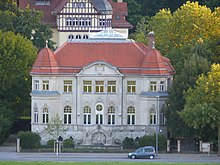Felix Schweighofer
Felix Schweighofer (born November 20, 1842 in Brno , † January 28, 1912 in Blasewitz near Dresden ; stage name also Felix Dammer ) was an Austrian actor and operetta singer .
Life
Felix Schweighofer, son of an accountant, made his debut in Krems in 1862 and played on various smaller stages until 1869, where he was successful as a young comedian. That year he got an engagement in Odessa , in the following year he moved to the city theater in Graz . From there, on the recommendation of Franz von Suppè, he moved to the Strampfer Theater in Vienna, then to the Theater an der Wien , where he was engaged from 1873 to 1883, after which he played two seasons at the Carltheater in Vienna. He became a successful character and vocal comedian, appearing in folk plays and antics. He was best known for his appearance in operetta world premieres: For example, he was the first Ollendorf in Karl Millöcker's begging student , but also in operetta world premieres by Johann Strauss (son) ( Blind Cow , The Merry War , The Queen's Lace Scarf ) he was on stage, in the Viennese premiere of One Night in Venice he embodied Pappacoda.
Because of his profession, there was a permanent rivalry with Alexander Girardi , which eventually led him to move to Germany as an actor and singer.
He had already given guest performances at the Residenztheater for several years and chose Dresden as his new home. Having become wealthy through his successes, he bought the Villa Leubnitzer Str. 18 for himself in the Swiss quarter around 1887 (destroyed in 1945, today the site of the Fritz-Löffler-Gymnasium ).
From 1901 he also made regular guest appearances at the Dresden Central Theater and in 1904, when he retired, said he had given guest appearances in 84 cities (including in 1899 at the Irving Place Theater in New York City ).
In 1904 he was able to have a villa built in Blasewitz (later Villa zur Lippe , today's address: Käthe-Kollwitz-Ufer 88), which he sold again in 1908 in order to purchase it on the neighboring property (today's address: Käthe-Kollwitz-Ufer 87) to have a new Felixhof villa built for himself and his second wife (destroyed in 1945).
He is buried in a crypt system made especially for his first wife Rosa (born Schaffer, 1841–1896) from French limestone and Lusatian granite on the Ev.-Luth. Johannisfriedhof in Dresden, where his second wife Friederike (“Fritzi Blum”, 1851–1945) was buried next to him. The central sculpture and the bronze medallions for this complex were created by Robert Diez , the architect was Paul Wallot . The facility was restored between 2014 and 2016.
A portrait of the actor, painted by Hermann Kaulbach in 1895 , is in the Gemäldegalerie Neue Meister (Inv.No. 2412A).
literature
- Ludwig Eisenberg : Large biographical lexicon of the German stage in the XIX. Century . Verlag von Paul List , Leipzig 1903, p. 947 ( Textarchiv - Internet Archive ).
- Christian Fastl: Schweighofer, Felix. In: Oesterreichisches Musiklexikon . Online edition, Vienna 2002 ff., ISBN 3-7001-3077-5 ; Print edition: Volume 5, Verlag der Österreichischen Akademie der Wissenschaften, Vienna 2006, ISBN 3-7001-3067-8 .
- H. Reitterer: Schweighofer, Felix. In: Austrian Biographical Lexicon 1815–1950 (ÖBL). Volume 12, Verlag der Österreichischen Akademie der Wissenschaften, Vienna 2001-2005, ISBN 3-7001-3580-7 , p. 41 f. (Direct links on p. 41 , p. 42 ).
- Felix Czeike (Ed.): Schweighofer Felix. In: Historisches Lexikon Wien . Volume 5, Kremayr & Scheriau, Vienna 1997, ISBN 3-218-00547-7 , p. 181 ( digitized version ). The place of death is incorrect.
Web links
- Felix Schweighofer in the Vienna History Wiki of the City of Vienna
- Martin Kaden: New “old things” discovered about the Schweighofergrab at the Johannisfriedhof! on freundeskreis-trinitatis-und-johannisfriedhof.de
- Photo of the tomb
Individual evidence
- ↑ Peter Gunold (Ed.): 50 years of the Dresden State Operetta - 225 years of the musical folk theater in Dresden . Läzer, Weimar 1997, p. 27.
- ^ Veit Haustein: Südvorstadt and Räcknitz with the Technical University - Dresden districts on historical postcards. Dresden 2014, OCLC 908617429 , p. 114.
- ↑ Detlef Eilfeld, Jochen Hänsch: The Dresdner Brunnenbuch - water in its most beautiful form. Volume II, SV Saxonia Verlag, Dresden o. J. (2016), ISBN 978-3-944210-75-9 , pp. 82-83.
| personal data | |
|---|---|
| SURNAME | Schweighofer, Felix |
| ALTERNATIVE NAMES | Dammer, Felix |
| BRIEF DESCRIPTION | Austrian actor and operetta singer |
| DATE OF BIRTH | November 20, 1842 |
| PLACE OF BIRTH | Brno |
| DATE OF DEATH | January 28, 1912 |
| Place of death | Blasewitz near Dresden |

